Cells
The Monastery has three cells located in Karyes. The remaining 14 cells are scattered through the forest at the northwest of the Monastery.
a) The Cell of All Saints is located north of the Cell of the Galatsians, and behind the building of the Holy Brotherhood. It was originally the residence of the members of the workshop of Karpenesian artists founded by Nikiforos. The Cell was founded by the Hieromonk Gabrielos of Karpenisi, who erected the church of All Saints there in 1681. The first artist of the cell known to have become famous by a 1788 written reference to him was Damaskinos. He succeeded Nikiforos I, who died in 1816 at the Zografos Monastery, and was in turn succeeded by Mitrofanis of Bizyi, who was probably tonsured as a monk there. Members of his group included Gerasimos and Ioasaf. Today, the cell houses the Antiprosopeia or Delegate’s House (i.e., the building where accommodation is provided to monks who have travelled to Karyes on behalf of the Monastery). Renovation work to structures within the cell were undertaken in 1999.
b) The Cell of the Three Hierarchs, where maintenance work was carried out in 1997.
c) The Cell of the Holy Precursor. A document of the 1648 Synod of Karyes refers to the earlier Cell of the Virgin Mary, which was granted to the monk Nikiforo.
d) The Cell of St Nikolaos, where the companions of the Hieromonk Nikolaos resided. Repair projects were recently completed there.
e) The Cell of the True Cross is located between the Karakallou Monastery and the Lavrian Cell of St Artemios, on a hill in the area of Provata, about a distance of a half-hour from the sea, in a wooded area with chestnut and cypress trees. A four-stremma expanse of land belongs to the cell, which has its own facilities for shoemaking, hair-cutting, weaving, ironworking, woodworking and photography. The cell was founded in the 10th century, and pieces of the True Cross and other holy relics are safeguarded in its church, including a piece of the cranium of the Holy Great Martyr Panteleimonos.
In 1896, the cell was sold by the Monastery to Russian monks, on the condition that the new owners would increase the number of buildings of the complex, with the obvious aim to transform it into a skete. In 1913, 70 monks lived in the cell, but after the Russian Revolution in October 1917, it started to steadily decline, ultimately leading to its abandonment and ruin.
In 1995, 1997 and 1999, repair projects were undertaken there. Today, the Elder of the cell is the hieromonk David Stavriotis, who is dedicated to producing censers and
elaborate marble and wood objects. On 4 October, the Cell celebrates the feast Exaltation of the True Cross with a festival. In 2017, the dedication ceremony for the refectory was performed by the Metropolite Ioakeim of Elenoupoli.
f) The Cell of the Presentation/Birth of the Virgin Mary (Galatsian), across from the northwest corner of the Protaton church, is where in 1819 the hieromonk Makarios Galatsianos, the founder the the hagiographic workshop of the same name, took up residence. The cell The Virgin Mary, the Presentation below Psorareas belonged to the Protaton and was transferred to the Monastery in 1661. The hieromonk Euthimios Stavroudas, the first biographer of St Nikolaos the Athonite, resided in the cell. In 1986, building work was done there.
g) The Cell of the Dormition of the Virgin, or ‘The Exopolytos’, originally was independent, but was transferred to the Monastery in 1324 by the Proto Isaak. and is recognized as an ‘old’ dependency. Today only the church survives.
h) The Cell of St Paraskevi, where in 1986 repairs to the roof and conservation of the chapel were undertaken.
i) The Cell of St Ipatios, which is referred to in a document of the Proto Ipatios and the 1568 Synod of Karyes in connection with a boundary dispute. Also, in a statement and evidence by the Konstamonitos Monastery in 1640, the ownership rights of the Monastery and the boundaries of the cell are recognized.
a) The Cell of All Saints is located north of the Cell of the Galatsians, and behind the building of the Holy Brotherhood. It was originally the residence of the members of the workshop of Karpenesian artists founded by Nikiforos. The Cell was founded by the Hieromonk Gabrielos of Karpenisi, who erected the church of All Saints there in 1681. The first artist of the cell known to have become famous by a 1788 written reference to him was Damaskinos. He succeeded Nikiforos I, who died in 1816 at the Zografos Monastery, and was in turn succeeded by Mitrofanis of Bizyi, who was probably tonsured as a monk there. Members of his group included Gerasimos and Ioasaf. Today, the cell houses the Antiprosopeia or Delegate’s House (i.e., the building where accommodation is provided to monks who have travelled to Karyes on behalf of the Monastery). Renovation work to structures within the cell were undertaken in 1999.
b) The Cell of the Three Hierarchs, where maintenance work was carried out in 1997.
c) The Cell of the Holy Precursor. A document of the 1648 Synod of Karyes refers to the earlier Cell of the Virgin Mary, which was granted to the monk Nikiforo.
d) The Cell of St Nikolaos, where the companions of the Hieromonk Nikolaos resided. Repair projects were recently completed there.
e) The Cell of the True Cross is located between the Karakallou Monastery and the Lavrian Cell of St Artemios, on a hill in the area of Provata, about a distance of a half-hour from the sea, in a wooded area with chestnut and cypress trees. A four-stremma expanse of land belongs to the cell, which has its own facilities for shoemaking, hair-cutting, weaving, ironworking, woodworking and photography. The cell was founded in the 10th century, and pieces of the True Cross and other holy relics are safeguarded in its church, including a piece of the cranium of the Holy Great Martyr Panteleimonos.
In 1896, the cell was sold by the Monastery to Russian monks, on the condition that the new owners would increase the number of buildings of the complex, with the obvious aim to transform it into a skete. In 1913, 70 monks lived in the cell, but after the Russian Revolution in October 1917, it started to steadily decline, ultimately leading to its abandonment and ruin.
In 1995, 1997 and 1999, repair projects were undertaken there. Today, the Elder of the cell is the hieromonk David Stavriotis, who is dedicated to producing censers and
elaborate marble and wood objects. On 4 October, the Cell celebrates the feast Exaltation of the True Cross with a festival. In 2017, the dedication ceremony for the refectory was performed by the Metropolite Ioakeim of Elenoupoli.
f) The Cell of the Presentation/Birth of the Virgin Mary (Galatsian), across from the northwest corner of the Protaton church, is where in 1819 the hieromonk Makarios Galatsianos, the founder the the hagiographic workshop of the same name, took up residence. The cell The Virgin Mary, the Presentation below Psorareas belonged to the Protaton and was transferred to the Monastery in 1661. The hieromonk Euthimios Stavroudas, the first biographer of St Nikolaos the Athonite, resided in the cell. In 1986, building work was done there.
g) The Cell of the Dormition of the Virgin, or ‘The Exopolytos’, originally was independent, but was transferred to the Monastery in 1324 by the Proto Isaak. and is recognized as an ‘old’ dependency. Today only the church survives.
h) The Cell of St Paraskevi, where in 1986 repairs to the roof and conservation of the chapel were undertaken.
i) The Cell of St Ipatios, which is referred to in a document of the Proto Ipatios and the 1568 Synod of Karyes in connection with a boundary dispute. Also, in a statement and evidence by the Konstamonitos Monastery in 1640, the ownership rights of the Monastery and the boundaries of the cell are recognized.

